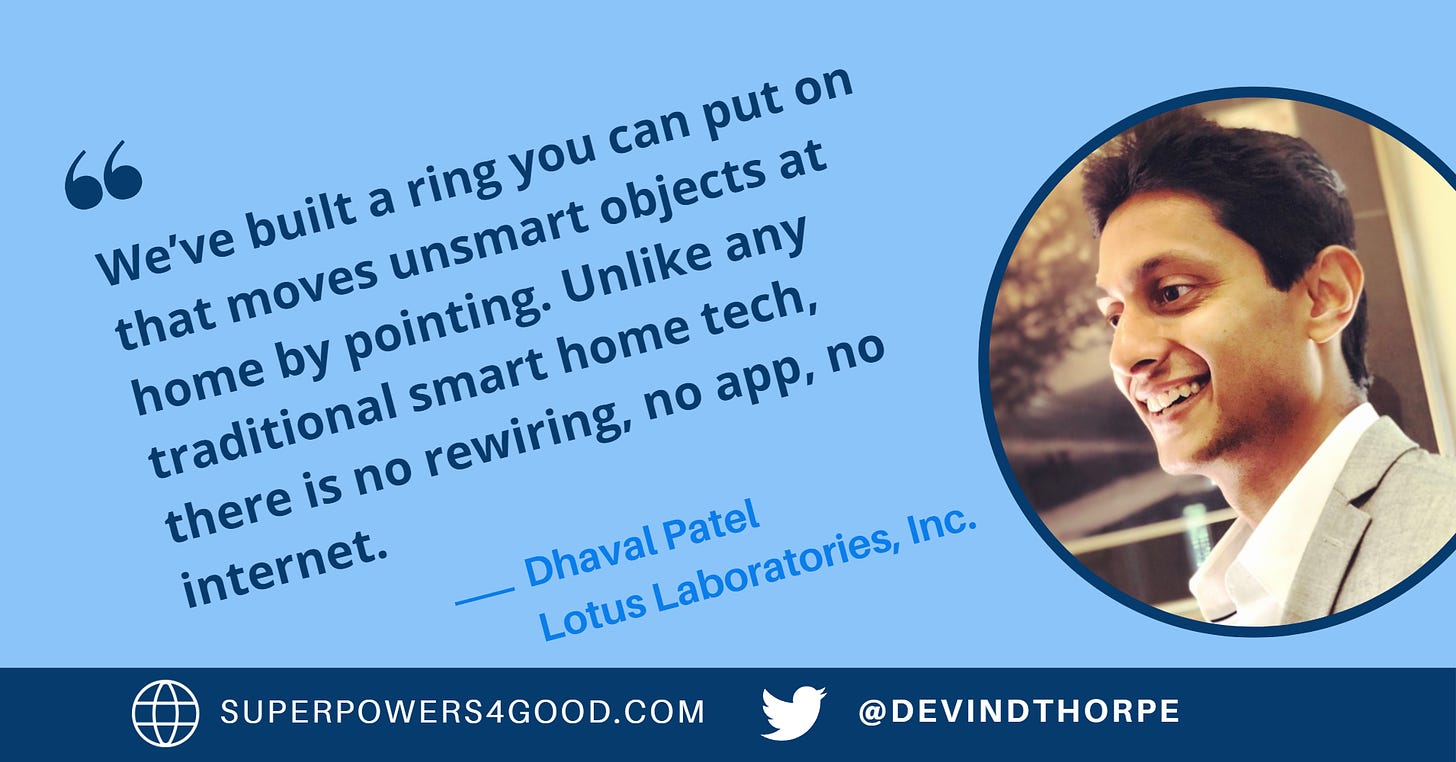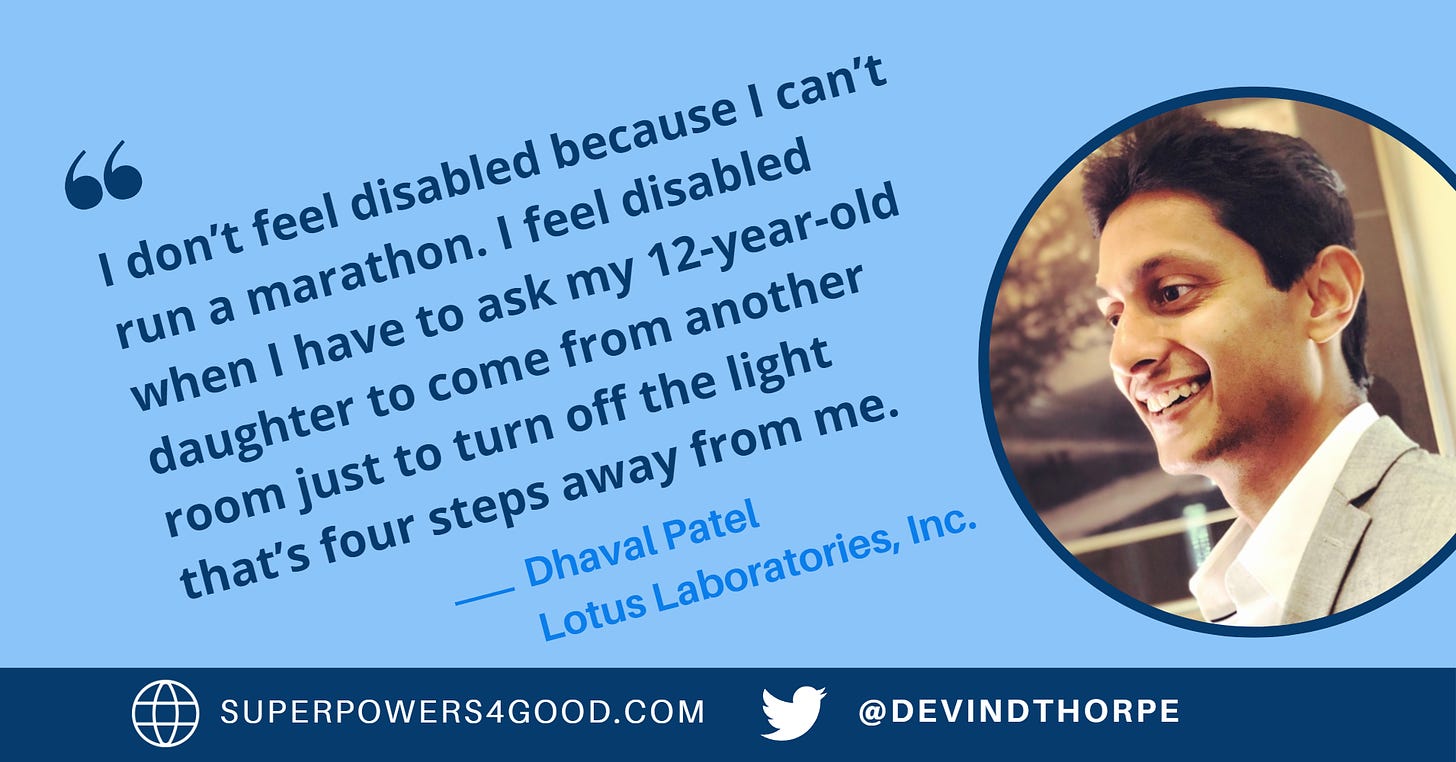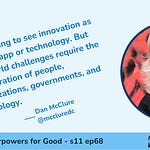Devin: What do you see as your superpower?
Dhaval: It would probably be simplicity. It’s something I got trained in at Apple—probably a little bit innate—but the ability to take a complex problem and simplify it to its essence. That’s probably my superpower if I had to pick one.
Working to solve a personal problem, Dhaval Patel, CEO and founder of Lotus Laboratories, has found a potential solution for a collection of problems faced by millions of people. His invention could help all of us!
One Ring to Rule It All
“We’ve built a ring you can put on that moves unsmart objects at home by pointing,” Dhaval says. “Unlike any traditional smart home tech, there is no rewiring, no app, no internet.”
The inspiration for the device is personal:
I have an intermittent short-term disability myself. So, in other words, I'm often on crutches for multiple months every year. One night I had just gotten into bed only to realize that I left the hallway lights on. But I was too exhausted to climb out of bed, hop on the crutches, hobble ten feet, turn off the light, hobble back ten feet and get back into bed.
So, I slept with the lights on the entire night and woke up in the morning not having slept well, thinking, wait a minute, if someone like me, an engineer—I have 38 patents in sensing and haptics working in big tech. I managed a division at Apple with expertise in wall electronics. If someone like me isn't even using smart home tech, who is really?
Diving in, he learned that 91 percent of homes were built before modern smart technology came online.
While a smart speaker is affordable, the work to make your home smart can be expensive and overwhelming. If you rent, as many do, it makes no sense to invest much in the wiring and electronics in a home you don’t own.
Dhaval’s ring effortlessly goes with you from room to room, so you don’t need a smart speaker in every room. The actuators that attach to switches in the house use magnets, so installation is almost instantaneous.
“Essentially, it lets you go from home to smart home in less than 60 seconds and at one-third the cost,” Dhaval says.
Dhaval describes how you install the tech:
It's a simple three-step process.
Well, step one, you just put the ring on. That's it. You put it on your forefinger, and there's a button so you can click it with your thumb.
Step two, we have these magnetically attachable skins that you can just attach to anything in your home, the most popular request being any kind of wall switch. It doesn't matter what it controls, it can control the wall switch.
Then the third: point and shoot.
After wall switches, curtains and faucets are the most requested applications. Lotus Laboratories is working on those solutions now.
The ring works on old-fashioned technology—the infrared signal used by a television remote beginning in the 1980s.
Dignity
Dhaval addresses the Lotus Laboratories mission from his personal vantage point. “I don’t feel disabled because I can’t run a marathon. I feel disabled when I have to ask my 12-year-old daughter to come from another room just to turn off the light that’s four steps away from me.”
Regardless of your wealth, “There are still some things you have to do just to exist,” he says. “You have to eat. You have to use the bathroom. You have to shower and change your clothes. To do those things, you have to get out of bed and move about around the house. Those six things are absolutely necessary. You can’t not do those things.”
“I don’t think of the product as the tech or even the device,” Dhaval says. “The product is actually for the caregiver and the care receiver. For the caregiver, it’s peace of mind. More importantly, for the care receiver, the product is dignity—the dignity you get from the independence of doing those intimate things alone.”
It is a wonder that more things aren’t made with this consciousness in mind. “The crazy part is disability is the only minority group you can join at any time by anyone.”
Furthermore, most of us only avoid disability with early death. Age delivers deteriorating vision, hearing and ambulation. “So why not build tech that’s optimized for our parents, our grandparents? And still usable and beneficial to everyone.”
Network Effects
One of the benefits Dhaval sees is the network effect. The ring and its installed components can be used by visitors wearing their own rings. Retail and commercial buildings can also add them to trigger doors, lights and other features.
This dynamic means that once launched, the value of the device will increase as more and more places adopt the technology. We don’t see the same benefit with other innovative home technology. I can’t turn on your lights without knowing what you call the lights I want to be turned on.
In just a few years, the affordable ring may become something we’re all wearing.
In this work to create life-changing, empowering technology, Dhaval has leveraged his superpower: simplicity.
How to Develop Simplicity As a Superpower
Dhaval is building Lotus Laboratories and its products using an ability he honed at Apple to simplify a complex problem into its essence.
He shared how he developed the vision for Lotus Laboratories by applying his superpower:
Let's talk about disability. If you talk to anybody else in the disability space, disability justice, disability advocacy, everyone, the first thing they will tell you is disability is a spectrum. There's not one type. Everyone has their own lived experience.
This is important. This is key. Your experience of using a wheelchair is probably not the same as mine because we have lived different lives. Someone who had polio as a child and has been using a wheelchair for 20 years—their experience is very different than, let's say, someone who unfortunately had a car accident and could walk up until yesterday.
Today, they're both using a wheelchair, but they have very, very different experiences.
I believe this is my mission in life; I want to build tech that is optimized for disability but usable by everyone.
Where do you start? It's this complex problem. I want to help disability by using my skill, which is building technology, specifically hardware tech. Where do you begin?
After a lot of interviews, I've distilled it down. And this is not perhaps the only way to explain it, but I'll tell you how I think of disability in a simple way now in my mind.
Disability can be described as a three-dimensional axis.
The first is how most of us tend to think about disability anatomically, what is not functioning as expected.
The second dimension is what that anatomical disability is preventing you from functionally doing. So maybe I can't clean my home. Maybe I can’t walk stairs. Maybe I can't take a shower.
So, the first is physical. Second is functional. This third axis is time. How did it happen, and how long is it going to last? It's a two-by-two matrix, right? Acute versus chronic on one axis and temporary versus permanent.
Now, I can tell you clearly where we want to start and ultimately help all of these people.
So our focus today on the anatomical front is to help mobility, disability. On the functional front is to help you with things you have to do every day at home. What's called often activities of daily living, making that easier. And on the third axis, acute, permanent, which is any kind of trauma. Veterans being the biggest, most important category there. And chronic permanent, which is elderly.
But the ability to take this extremely complex “what is disability?” We all have different experiences to distill it down to that framework. So, now I can engineer a solution for specifically the people I'm trying to help. That is very powerful. That's a very powerful mindset because what previously seemed like this massive, amorphous problem statement is now definitive.
The key here is a framework. I tend to create a framework for pretty much anything I'm thinking about, and I find it helps me traverse any kind of massively complex space, including philosophy. Much cleaner. Much, much more efficiently.
So, I asked Dhaval to explain how he creates the framework, how he finds the essence in complexity so we can all learn to do that better. He identified three key steps:
Collect information. “Usually, the first part of the process is just collecting information. It’s uncategorized. You just go talk to everyone and read whatever you need to research the problem. It’s usually disparate. It’s usually amorphous all over the place. The analogy I would use is to collect all your Lego blocks and find them everywhere that they are, and pile them up in one spot.”
Categorize the data. “Step two is finding fundamental building blocks. So if you’ve built if you’ve piled up all your Lego blocks, categorize them. Bucket them in, ‘oh, these all tend to be just rectangles. These tend to be squares. These tend to be these pillar-shaped things.’ You’ll often find even in a massively complex heap of information, you can find buckets. Oftentimes, because the mind is trying to use the least amount of mental effort to get through whatever you’re trying to do, it has this natural tendency to bucketize information.
Connect the dots. Once you found the buckets, what is the simplest explanation or framework that can connect those dots? That last part sounds simpler than it is. You have to keep chipping away. The analogy I like to use is it’s something that’s working in your mind as you are driving along or taking a shower, or doing your laundry. Imagine if you had a stone and you were chipping away at it every time you were thinking about it. Over time, this sculpture will emerge.
Dhaval offers some advice for putting your work, family and fun in context.
The purpose of my life is, and I think this applies to most people, to spend time doing things you love with people you love and spend your time doing something meaningful, whatever that means to you.
If you do just one or the other, you won't, at the end of your life, feel it's purposeful if you only spend time doing things you love with people who love. Let's say you travel the world, do everything, and you're a billionaire, and that's all you do. You may not feel you had a fulfilled life or purposeful life.
But on the other hand, if all you do is do purposeful work, if you're working all the time and you're helping tons of people, but you never had the opportunity to spend time with people you love, then maybe you've missed out.
The combination is the essence. So, one of the things we talk about at Lotus all the time is it's not work-life balance; it's life-work balance because life comes first.
By following Dhaval’s example and advice, you can make simplicity a superpower than enables you to do more good in the world.

























Life Could Be About to Get Easier